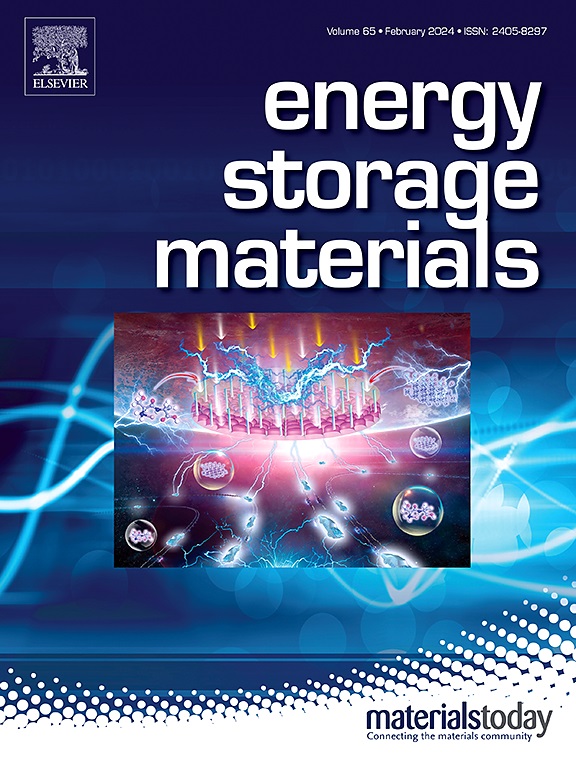A cross-linked AB-type alternating perfluoroalkyl-ethylene oxide polymer electrolyte for high-performance all-solid-state lithium-metal batteries
IF 20.2
1区 材料科学
Q1 CHEMISTRY, PHYSICAL
引用次数: 0
Abstract
Poly(ethylene oxide) (PEO) derivatives are attractive Li+-conducting solid polymer electrolytes (SPEs) due to their high lithium salt solubility but face challenges with low ionic conductivity and interfacial stability. In contrast, fluorinated polymers offer superior chemical and mechanical stability but limited salt solubility and conductivity. To address these challenges, we developed a cross-linked AB-type alternating copolymer electrolyte, poly(TEGDVE-OFDIB)-LiTFSI, via iodo-ene photopolymerization of triethylene glycol divinyl ether (TEGDVE) and octafluoro-1,4-diiodobutane (OFDIB) in the presence of LiTFSI. TEGDVE enhances film flexibility and cross-linking while enabling Li+ transport through sequential Li+ coordination and decoordination, whereas OFDIB serves as both a structural spacer and electrostatic mediator, with its negative electrostatic potential stabilizing the electrochemical interface while facilitating Li+ conduction between TEGDVE units. The resulting SPE achieves a Li+ conductivity of 1.3 × 10−4 S cm−1, a transference number of 0.55, and a stability window of 4.98 V at 40 ℃. All solid-state lithium-metal batteries (ASSLMBs) with a LiFePO4 cathode and the SPE retain 100 % capacity over 500 cycles at 0.5C. With an NMC811 cathode, the cell delivers an initial capacity of 157.7 mAh g−1 with 80 % capacity retention after 100 cycles. This work establishes iodo-ene polymerization as a versatile strategy for designing high-performance AB-type alternating copolymer electrolytes for ASSLMBs.


高性能全固态锂金属电池用交联ab型交联全氟烷基-环氧乙烷聚合物电解质
聚环氧乙烷(PEO)衍生物由于具有较高的锂盐溶解度而成为极具吸引力的锂离子导电固体聚合物电解质(spe),但面临离子电导率低和界面稳定性差的挑战。相比之下,氟化聚合物具有优越的化学和机械稳定性,但盐溶解度和导电性有限。为了解决这些问题,我们开发了一种交联ab型交替共聚物电解质,聚(TEGDVE-OFDIB)-LiTFSI,在LiTFSI存在下,通过碘烯光聚合三甘醇二乙烯基醚(TEGDVE)和八氟-1,4-二碘丁烷(OFDIB)。TEGDVE增强了膜的柔韧性和交联性,同时使Li+能够通过连续的Li+配位和协调传输,而OFDIB既是结构间隔器又是静电介质——其负静电势稳定了电化学界面,同时促进了Li+在TEGDVE单元之间的传导。得到的SPE使得Li +的电导率为1.3 × 10⁻4 S cm⁻1,迁移数为0.55,在40℃时的稳定窗口为4.98 V。所有采用LiFePO4阴极和SPE的固态锂金属电池(asslmb)在0.5℃下循环500次后仍能保持100%的容量。采用NMC811阴极,电池的初始容量为157.7 mAh g - 1, 100次循环后容量保持80%。这项工作建立了碘-烯聚合作为设计高性能ab型交替共聚物电解质asslmb的通用策略。
本文章由计算机程序翻译,如有差异,请以英文原文为准。
求助全文
约1分钟内获得全文
求助全文
来源期刊

Energy Storage Materials
Materials Science-General Materials Science
CiteScore
33.00
自引率
5.90%
发文量
652
审稿时长
27 days
期刊介绍:
Energy Storage Materials is a global interdisciplinary journal dedicated to sharing scientific and technological advancements in materials and devices for advanced energy storage and related energy conversion, such as in metal-O2 batteries. The journal features comprehensive research articles, including full papers and short communications, as well as authoritative feature articles and reviews by leading experts in the field.
Energy Storage Materials covers a wide range of topics, including the synthesis, fabrication, structure, properties, performance, and technological applications of energy storage materials. Additionally, the journal explores strategies, policies, and developments in the field of energy storage materials and devices for sustainable energy.
Published papers are selected based on their scientific and technological significance, their ability to provide valuable new knowledge, and their relevance to the international research community.
 求助内容:
求助内容: 应助结果提醒方式:
应助结果提醒方式:


